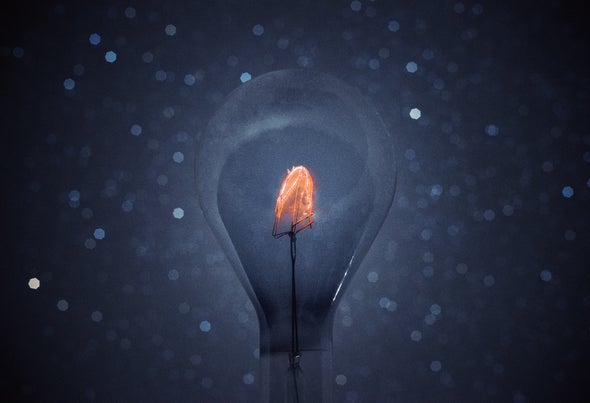(单词翻译:单击)
听力文本
This is Scientific American — 60-Second Science, I'm Susanne Bard.
Switching on the lights at night is second nature to most people in the developed world. But electricity isn't a given in many other parts of the globe.
"Something like a billion people on our planet still lack reliable access to electricity. Think about folks in parts of the developing world that are living in off-grid locations. And for them, one of the central applications of electricity is lighting, and we need lighting the most at night."
U.C.L.A. materials scientist Aaswath Raman. Solar cells can provide remote areas with electricity during the day but require batteries to store that energy for use at night. Raman's team has developed a potential solution: a simple thermoelectric device that generates power when it's exposed to the cold night sky. It's made possible by a phenomenon called radiative sky cooling.
All objects, Raman explains, radiate heat. "And so what that means from the perspective of a surface that's looking up at the night sky is that it will, all by itself, send out more heat than the sky sends back to it. It escapes to the upper atmosphere and even out to outer space. And it's something that anyone can observe at night. So if you go and measure the roof temperature on your house in the early morning hours, say, you should read a temperature that is much lower than the immediate ambient air temperature."

Raman reasoned that this temperature difference could be exploited to generate electricity. His team built their device using an aluminum disk that acts as a radiative cooler. Its cool side faces the night sky, while its other side is warmed by the air around it. As heat escapes upwards, a thermoelectric generator converts the temperature difference into electricity that powers a small LED light.
For now, the energy output of the device is just a tiny fraction of what a solar cell can produce. But engineering improvements could eventually boost its performance. Raman sees the device as a complement to solar, providing inexpensive, 24-hour power generation to remote areas of the world—without the need for batteries.
"You can also think about, say, the polar regions, where for several months of the year, there is no sun at all. So in those kinds of regions, this might represent one of the few ways you can actually generate power naturally at night." The research is described in the journal Joule.
In addition to lighting, Raman says the device could be useful for specialized applications, such as powering wireless sensors and monitoring atmospheric conditions. Or it could be a really cool way to recharge your cell phone at night.
Thanks for listening for Scientific American — 60-Second Science. I'm Susanne Bard.
参考译文
这里是科学美国人——60秒科学系列,我是苏珊娜·巴德。
对大多数发达国家的居民来说,夜晚开灯是第二天性。但世界上还有许多地方尚未通电。
“地球上大约有10亿人仍然缺乏可靠的电力供应。想想那些生活在发展中国家离网区的人们。对他们来说,电力的核心应用之一就是照明,而我们在夜晚最需要照明。”
加州大学洛杉矶分校的材料科学家阿斯沃斯·拉曼说到。太阳能电池可在白天为偏远地区提供电力,但需要电池储存能量以备夜间使用。拉曼的团队已经开发出可能的解决方案:一种暴露在寒冷的夜空就能发电的简单热电设备。这是由“天空辐射冷却”现象实现的可能性。
拉曼解释说,所有物体都会散发热量。“所以,从仰望夜空表面的角度来看,这意味着表面自身散发的热量比天空反射回来的热量要多。热量逃到上层大气,甚至逃出外层空间。这是任何人都可以在晚上观察到的情况。因此,如果你在清晨测量自家房子的屋顶温度,你应该会看到比即时周围气温低得多的温度。”
拉曼认为这种温差可以用来发电。他的团队用铝盘当作辐射冷却器,制作出他们的设备。其冷却面朝向夜空,另一面则被周围的空气温暖着。当热量向上逃逸时,热电发电机将温差转化为电能,这种电能可为小型LED灯供电。
目前,与太阳能电池发电相比,该设备的能量输出相当少。但工程改进最终可能会提高其性能。拉曼将该设备视为太阳能的补充,可以24小时为世界偏远地区提供廉价的电力生产,而且无需电池。
“你可以想想极地地区,那里一年中有几个月完全没有阳光。所以在这些地区,这也许是可在夜间自然发电的几种方式之一。”这项研究发表在《焦耳》期刊上。
拉曼表示,除了照明,这种设备还可以用于特殊用途,比如为无线传感器供电和监测大气状况。或者还可以成为夜间给手机充电的超酷方式。
谢谢大家收听科学美国人——60秒科学。我是苏珊娜·巴德。
译文为可可英语翻译,未经授权请勿转载!
重点讲解
重点讲解:
1. switch on 打开,开启(电灯等);
He didn't bother to switch on the light.
他懒得去开灯。
2. be exposed to 使暴露于;
They were exposed to radioactive fallout during nuclear weapons tests.
在核武器试验中他们暴露在放射性尘埃之下。
3. send out 发出(信号、声音、光、热等);
Like bats, they send out sound waves and make sense of their environment from the echoes they receive back.
像蝙蝠一样,它们发出声波,然后根据收到的回音来了解周围的环境。
4. convert into (使)改变;更改;(使)转变;
The signal will be converted into digital code.
信号会被转变为数字代码。


